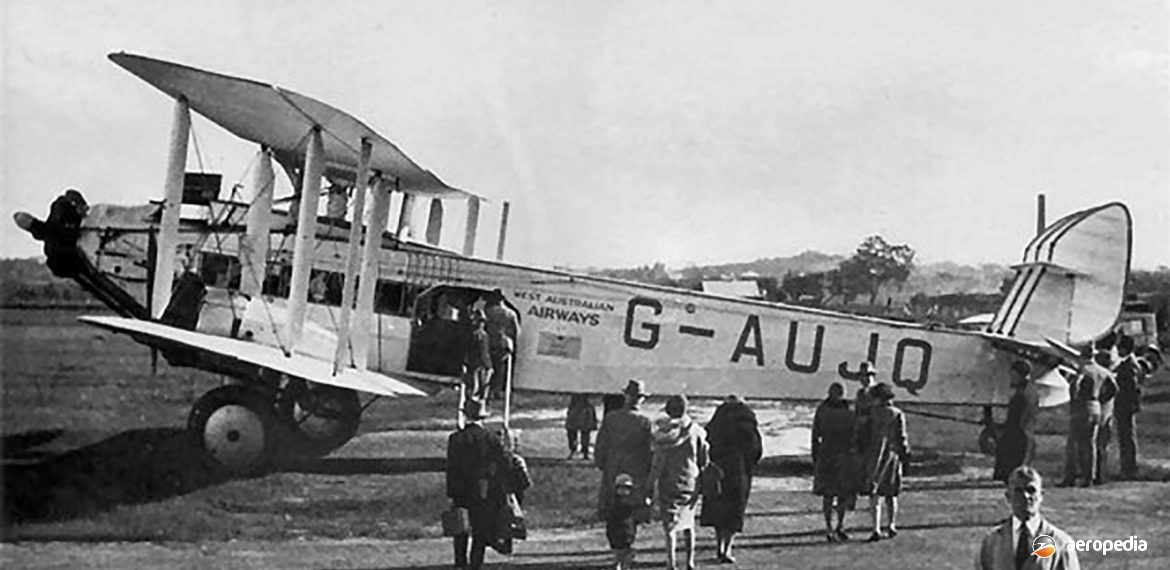Photograph:
de Havilland DH.66 Hercules G-AUJQ (c/n 346) at Perth, WA (Eddie Coates collection)
Country of origin:
United Kingdom
Description:
Commercial airliner
Power Plant:
Three 313 kw (420 hp) Bristol Jupiter VI nine-cylinder air-cooled radial engines
Specifications:
- Wingspan: 24.23 m (79 ft 6 in)
- Length: 17.08 m (56 ft)
- Height: 5.56 m (18 ft 3 in)
- Wing area: 143.71 m² (1,547 sq ft)
- Max speed: 209 km/h (130 mph)
- Cruising speed: 177 km/h (110 mph)
- Stalling speed: 84 km/h (52 mph)
- Rate of climb at sea level: 233 m/min (765 ft/min)
- Absolute ceiling: 3,962 m (13,000 ft)
- Range: 845 km (525 miles)
- Fuel capacity: 1,365 litres (300 Imp gals)
- Empty weight: 4,382 kg (9,660 lb)
- Max payload weight with crew: 1,318 kg (2,900 lb)
- Loaded weight: 7,076 kg (15,600 lb)
History:
In 1925 de Havilland designed a large biplane powered by three air-cooled radial engines known as the DH.66 Hercules. It was an equal-span biplane with single wing-bays outboard of the wing-mounted engines. The wings were of wooden construction, with two box spars, the leading and trailing-edges being of duralumin tubing and the surfaces being covered with fabric. The fuselage was a wire-braced steel tube structure with fabric covering.
Designed to carry 14 passengers, the type entered service with Imperial Airways, the second aircraft G-EBMX (c/n 237) making a survey flight to India in December 1927, later going to the South African Air Force. The DH.66 Hercules operated Imperial Airways routes to India and Africa for some years, the aircraft all being named after cities on its routes, ie ‘City of Cairo’, ‘City of Delhi’, ‘City of Baghdad”, etc.
In 1931 the airline’s service to India was extended, for mail, to Australia but problems occurred when an aircraft G-EBMW (c/n 236 – ‘City of Cairo’) was lost in bad weather near Koepang on Timor on 19 April that year. Although only eleven aircraft in the series were built, it was an important aircraft in that it was one of the first large airliners in this region.
In 1928 Western Australian Airways was granted a subsidy for mail services on its routes, and to this end four DH.66s were obtained, these differing from Imperial Airways machines in seating 14 passengers, having enclosed cockpits, and having larger diameter tailwheels. The aircraft all operated initially with their G-AU?? registrations but the registrations of all Australian aircraft had become VH- by the end of August 1930.
A proving flight was made by Major Norman Brearley in May 1929 and the type was soon placed in service. The first VH-UJO (c/n 344 – ex G-AAJH, G-AUJO) entered service as ‘City of Perth’ on 28 May 1929 and continued until April 1936 when it was sold to E J Stephens of Stephens Aviation Ltd in Papua New Guinea. This, and its sister aircraft, was mainly used in carrying freight from the coast to Wau. It crashed off Salamaua Beach on 6 February 1941.
The second DH.66 Hercules VH-UJP (c/n 345 – ex G-AUJP) entered service as ‘City of Adelaide‘ and also operated with Western Australian Airways Ltd until sold to Stephens Aviation Transport Company in August 1937. This company later changed its name to Stephens Aviation Ltd. VH-UJP crashed into the sea off Kong Point at Salamaua on 27 July 1940, was salvaged and was rebuilt, but was eventually destroyed by Japanese forces on 27 July 1940.
The third DH.66 VH-UJQ (c/n 346 – ex G-AUJQ) operated with Western Australian Airways Ltd from 29 May 1929. On 26 May 1931 it was sold to Imperial Airways, with which it operated as ‘City of Cape Town’ as G-ABMT. It later went to Alan Cobham (later Sir), Imperial Airways, and the South African Air Force in July 1934, being written off in April 1943.
The fourth DH.66 aircraft VH-UJR (c/n 347 – ex G-AUJR) was delivered to Western Australian Airways on 21 June 1929. However, one year later it was sold to Imperial Airways as G-ABCP with which it operated as ‘City of Jodphur’ until it crashed in Salisbury, Rhodesia on 23 November 1935.

